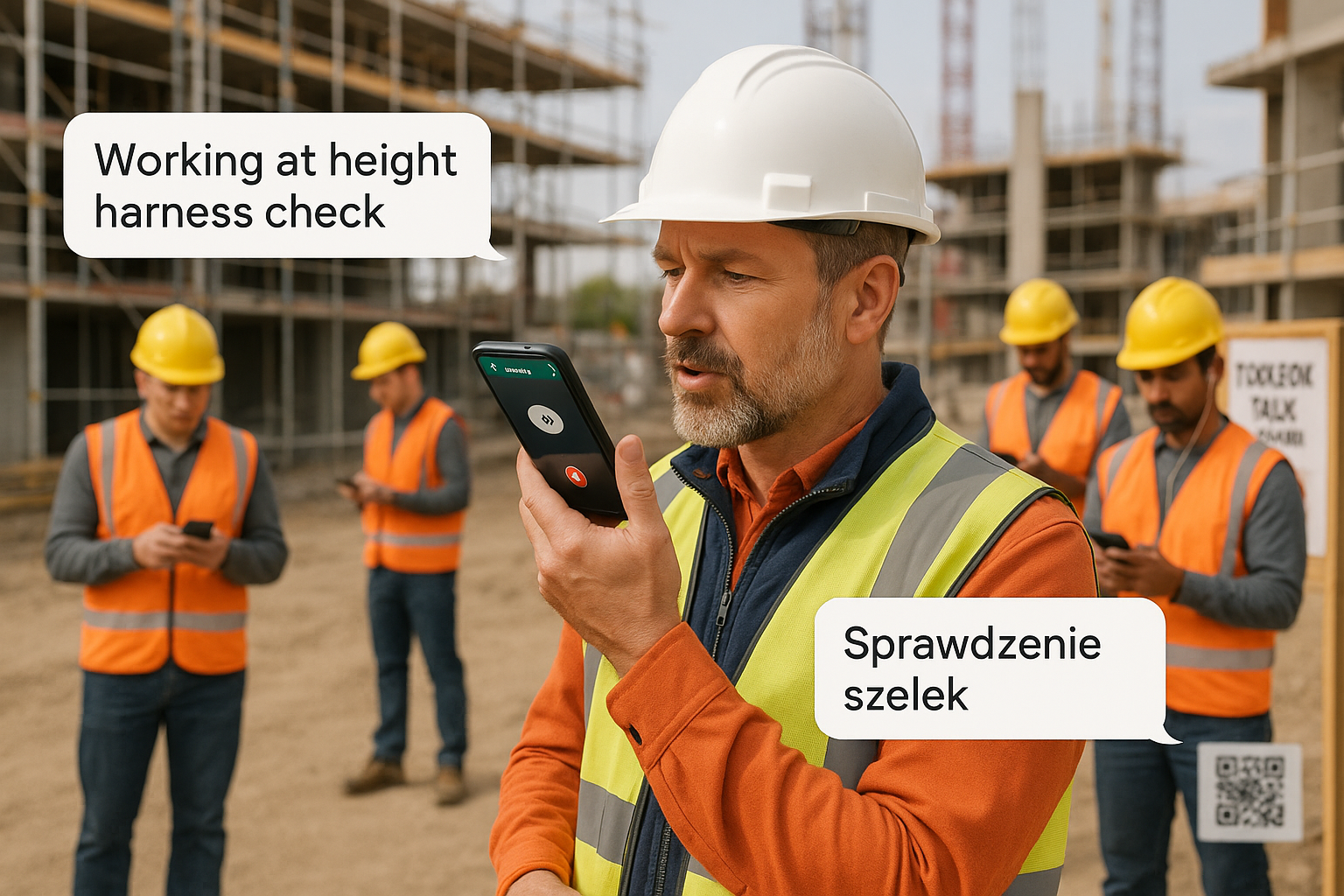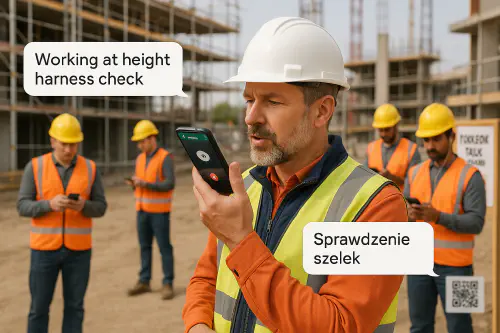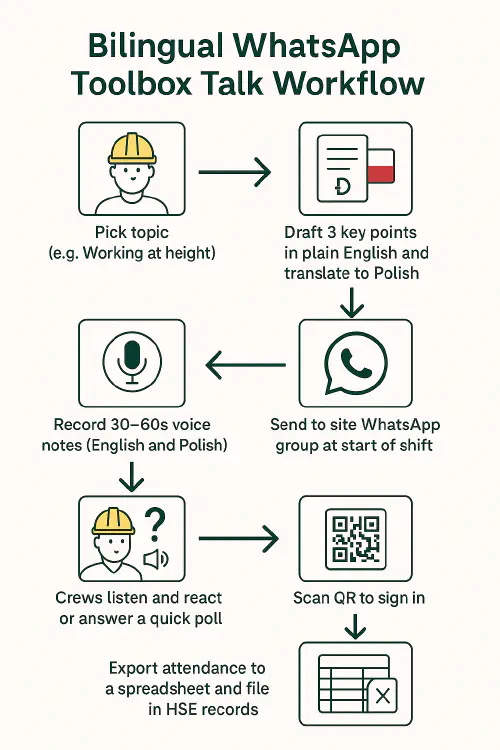
Bilingual toolbox talks on WhatsApp: 3‑minute voice notes that crews actually understand
Bilingual toolbox talks on WhatsApp: 3‑minute voice notes that crews actually understand
Category: Hiring, Training & HR • Niche: WhatsApp micro‑learning, toolbox talks, multilingual crews, CSCS workflows
Contents
- Quick answer
- Why this matters on UK sites now
- What you need
- Step‑by‑step setup
- Flowchart: the workflow at a glance
- Topics you can use this week
- Make it compliant: GDPR and records
- What are people saying on Reddit?
- Helpful links
- FAQ

Foreman recording a bilingual WhatsApp toolbox talk voice note on a UK construction site
Quick answer
Use WhatsApp voice notes to deliver a 3‑minute toolbox talk in two languages (for example English and Polish). Keep it to 3 points, add a WhatsApp poll to check understanding, and log attendance with a QR sign‑in. Store the poll result and attendance sheet with your RAMS. This keeps briefings short, relevant and auditable under CDM.
Why this matters on UK sites now
- Mixed‑language crews are common and language gaps increase incident risk on dynamic tasks. Clear voice notes beat long text for speed and comprehension on a noisy site.
- CITB’s HS&E Operatives test already supports multiple voice‑over languages including Polish, Romanian and Spanish, signalling the scale of the language need on UK sites. See CITB’s HS&E overview for details and options like BSL. CITB HS&E test
- HSE endorses short, focused toolbox talks targeting one risk at a time. HSE toolbox talks
What you need
- A WhatsApp group per site or crew.
- A simple topics list tied to your live RAMS.
- Someone bilingual on the team or a trusted translator to prep the second language. Avoid auto‑translate for safety‑critical messages unless reviewed.
- A QR attendance form. If you need a setup, see our guide: Toolbox talk attendance QR code: set it up with Google Forms and Sheets
Step‑by‑step setup
1. Pick a topic tied to real risks
- Choose one hazard for today based on the workface: working at height, MEWPs, hot works, lifting ops, temporary electrics, housekeeping.
- Pull 1 recent near miss or observation to keep it real.
2. Write 3 plain‑English points, then translate
- Use a 3‑point script in simple English at roughly CEFR B1 reading level.
- Translate to the second language your crew needs. If in doubt, ask a bilingual supervisor/worker to review.
- Keep wording consistent with your RAMS and signage.
Example (English → Polish)
Clip onto approved anchor points only.
Inspect harness and lanyard before use.
Keep edges protected and tools tethered.
Zaczepiaj tylko do zatwierdzonych punktów kotwiczenia.
Sprawdź szelki i lonżę przed użyciem.
Chroń krawędzie i zabezpieczaj narzędzia smyczą.
3. Record 30–60s voice notes in two languages
- Record two short WhatsApp voice notes, one per language. Aim for clear pace, name the risk, give the 3 points, and end with what to do if unsure.
- Optional: attach a photo of today’s area highlighting controls.
4. Send to WhatsApp groups at start of shift
- Post the English note then the translated note. Pin the messages.
- Add a simple title line so they are searchable later, for example: Toolbox Talk Working at height 2025‑09‑23.
5. Capture understanding with a quick poll or reaction
- Add a WhatsApp poll right after the notes with one key question (for example Do you need an anchor point for a restraint lanyard? Yes/No). Briefly discuss responses.
- Or ask for a thumbs‑up reaction to confirm they listened. Polls are better for evidence.
6. Log attendance with a QR sign‑in
- Print a small QR poster at the signing‑in point. Workers scan, enter name and site, and hit submit as they start shift.
- The sheet lives in Google Sheets or Excel for export and filing. See our setup guide linked above.
7. File evidence
- Save the WhatsApp poll screenshot and export the attendance list. File with the day’s RAMS/POWRA pack.
- Note any actions agreed in the site diary. For an AI‑assisted diary workflow, see: Build an AI site diary from photos and voice notes
Flowchart: the workflow at a glance

Bilingual WhatsApp toolbox talk workflow: pick topic, write 3 points, record two voice notes, send to group, poll, QR sign-in, export records
Topics you can use this week
- Working at height: harness and anchor checks, edge protection, platform housekeeping.
- MEWPs: pothole protection, secondary guarding, spotter role.
- Manual handling: team lifts, use of trolleys, avoid twisting.
- Temporary electrics: RCD checks, 110V only, lock‑out basics.
- Cutting and grinding: eye/face protection, sparks control, hot works permit.
- Housekeeping: keep routes clear, stacking materials, spill control.
- Weather: heat stress, cold stress, wind limits for lifting/roof work.
Tip: Rotate 5–7 core topics and add incident‑led refreshers.
Make it compliant: GDPR and records
- Use corporate channels where possible and set a simple BYOD/messaging policy if WhatsApp is used. Require screen locks and updates on devices.
- Keep it proportionate: avoid sharing health data; use WhatsApp for delivery and quick checks, then file records in your official system.
- Subject access requests: if business discussions happen in WhatsApp, move key decisions and attendance into your official records so you can retrieve them later. See ICO guidance on BYOD, monitoring and non‑corporate channels: ICO working from home security, ICO monitoring workers, ICO official info in private channels
What are people saying on Reddit?
- Mixed‑language comms are a daily headache on many sites. Supervisors report better engagement when they switch to short voice notes and visuals. (Community threads vary, but the pattern is consistent across UK trade forums.)
Helpful links
- CITB HS&E test: languages and booking options CITB HS&E test
- Official toolbox talks hub HSE: Toolbox talks
- Related Academy guides